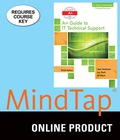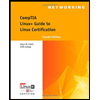
MINDTAP COMPUTING FOR ANDREWS' A+ GUIDE
9th Edition
ISBN: 9781305944558
Author: ANDREWS
Publisher: Cengage Learning
expand_more
expand_more
format_list_bulleted
Expert Solution & Answer
Chapter 20, Problem 5RTB
Explanation of Solution
Given: The Linux command.
To find:Â The Linux command that provides information about the shell in use.
Solution:Â
Expert Solution & Answer
Want to see the full answer?
Check out a sample textbook solution
Students have asked these similar questions
How does encryption prevent a hacker from getting your data
what is one way to secure a phone
why are SMishing attacks particularily effective?
Chapter 20 Solutions
MINDTAP COMPUTING FOR ANDREWS' A+ GUIDE
Knowledge Booster
Similar questions
- Activity No. Activity Time (weeks) Immediate Predecessors 1 Requirements collection 3 2 Requirements structuring 4 1 3 Process analysis 3 2 4 Data analysis 3 2 5 Logical design 50 3,4 6 Physical design 5 5 7 Implementation 6 6 c. Using the information from part b, prepare a network diagram. Identify the critical path.arrow_forwardGiven the following Extended-BNF grammar of the basic mathematical expressions: Show the derivation steps for the expression: ( 2 + 3 ) * 6 – 20 / ( 3 + 1 ) Draw the parsing tree of this expression. SEE IMAGEarrow_forwardWhentheuserenters!!,themostrecentcommandinthehistoryisexecuted.In the example above, if the user entered the command: Osh> !! The ‘ls -l’ command should be executed and echoed on user’s screen. The command should also be placed in the history buffer as the next command. Whentheuserentersasingle!followedbyanintegerN,theNthcommandin the history is executed. In the example above, if the user entered the command: Osh> ! 3 The ‘ps’ command should be executed and echoed on the user’s screen. The command should also be placed in the history buffer as the next command. Error handling: The program should also manage basic error handling. For example, if there are no commands in the history, entering !! should result in a message “No commands in history.” Also, if there is no command corresponding to the number entered with the single !, the program should output "No such command in history."arrow_forward
- Activity No. Activity Time (weeks) Immediate Predecessors 1 Requirements collection 3 2 Requirements structuring 4 1 3 Process analysis 3 2 4 Data analysis 3 2 5 Logical design 50 3,4 6 Physical design 5 5 7 Implementation 6 6 c. Using the information from part b, prepare a network diagram. Identify the critical path.arrow_forward2. UNIX Shell and History Feature [20 points] This question consists of designing a C program to serve as a shell interface that accepts user commands and then executes each command in a separate process. A shell interface gives the user a prompt, after which the next command is entered. The example below illustrates the prompt osh> and the user's next command: cat prog.c. The UNIX/Linux cat command displays the contents of the file prog.c on the terminal using the UNIX/Linux cat command and your program needs to do the same. osh> cat prog.c The above can be achieved by running your shell interface as a parent process. Every time a command is entered, you create a child process by using fork(), which then executes the user's command using one of the system calls in the exec() family (as described in Chapter 3). A C program that provides the general operations of a command-line shell can be seen below. #include #include #define MAX LINE 80 /* The maximum length command */ { int…arrow_forwardQuestion#2: Design and implement a Java program using Abstract Factory and Singleton design patterns. The program displays date and time in one of the following two formats: Format 1: Date: MM/DD/YYYY Time: HH:MM:SS Format 2: Date: DD-MM-YYYY Time: SS,MM,HH The following is how the program works. In the beginning, the program asks the user what display format that she wants. Then the program continuously asks the user to give one of the following commands, and performs the corresponding task. Note that the program gets the current date and time from the system clock (use the appropriate Java date and time operations for this). 'd' display current date 't': display current time 'q': quit the program. • In the program, there should be 2 product hierarchies: "DateObject” and “TimeObject”. Each hierarchy should have format and format2 described above. • Implement the factories as singletons. • Run your code and attach screenshots of the results. • Draw a UML class diagram for the program.arrow_forward
- #include <linux/module.h> #include <linux/kernel.h> // part 2 #include <linux/sched.h> // part 2 extra #include <linux/hash.h> #include <linux/gcd.h> #include <asm/param.h> #include <linux/jiffies.h> void print_init_PCB(void) { printk(KERN_INFO "init_task pid:%d\n", init_task.pid); printk(KERN_INFO "init_task state:%lu\n", init_task.state); printk(KERN_INFO "init_task flags:%d\n", init_task.flags); printk(KERN_INFO "init_task runtime priority:%d\n", init_task.rt_priority); printk(KERN_INFO "init_task process policy:%d\n", init_task.policy); printk(KERN_INFO "init_task task group id:%d\n", init_task.tgid); } /* This function is called when the module is loaded. */ int simple_init(void) { printk(KERN_INFO "Loading Module\n"); print_init_PCB(); printk(KERN_INFO "Golden Ration Prime = %lu\n", GOLDEN_RATIO_PRIME); printk(KERN_INFO "HZ = %d\n", HZ); printk(KERN_INFO "enter jiffies = %lu\n", jiffies); return 0; } /* This function is called when the…arrow_forwardList at least five Operating Systems you know. What is the difference between the kernel mode and the user mode for the Linux? What is the system-call? Give an example of API in OS that use the system-call. What is cache? Why the CPU has cache? What is the difference between the Static Linking and Dynamic Linking when compiling the code.arrow_forwardIn the GoF book, List interface is defined as follows: interface List { int count(); //return the current number of elements in the list Object get(int index); //return the object at the index in the list Object first(); //return the first object in the list Object last(); //return the last object in the list boolean include(Object obj); //return true is the object in the list void append(Object obj); //append the object to the end of the list void prepend(Object obj); //insert the object to the front of the list void delete(Object obj); //remove the object from the list void deleteLast(); //remove the last element of the list void deleteFirst(); //remove the first element of the list void deleteAll(); //remove all elements of the list (a) Write a class adapter to adapt Java ArrayList to GoF List interface. (b) Write a main program to test your adapters through List interface. (c) Same requirement as (a) and (b), but write an object adapter to adapt Java ArrayList to GoF List…arrow_forward
arrow_back_ios
SEE MORE QUESTIONS
arrow_forward_ios
Recommended textbooks for you
 A+ Guide To It Technical SupportComputer ScienceISBN:9780357108291Author:ANDREWS, Jean.Publisher:Cengage,
A+ Guide To It Technical SupportComputer ScienceISBN:9780357108291Author:ANDREWS, Jean.Publisher:Cengage, LINUX+ AND LPIC-1 GDE.TO LINUX CERTIF.Computer ScienceISBN:9781337569798Author:ECKERTPublisher:CENGAGE L
LINUX+ AND LPIC-1 GDE.TO LINUX CERTIF.Computer ScienceISBN:9781337569798Author:ECKERTPublisher:CENGAGE L CompTIA Linux+ Guide to Linux Certification (Mind...Computer ScienceISBN:9781305107168Author:Jason EckertPublisher:Cengage Learning
CompTIA Linux+ Guide to Linux Certification (Mind...Computer ScienceISBN:9781305107168Author:Jason EckertPublisher:Cengage Learning A+ Guide to Hardware (Standalone Book) (MindTap C...Computer ScienceISBN:9781305266452Author:Jean AndrewsPublisher:Cengage Learning
A+ Guide to Hardware (Standalone Book) (MindTap C...Computer ScienceISBN:9781305266452Author:Jean AndrewsPublisher:Cengage Learning

A+ Guide To It Technical Support
Computer Science
ISBN:9780357108291
Author:ANDREWS, Jean.
Publisher:Cengage,

LINUX+ AND LPIC-1 GDE.TO LINUX CERTIF.
Computer Science
ISBN:9781337569798
Author:ECKERT
Publisher:CENGAGE L

CompTIA Linux+ Guide to Linux Certification (Mind...
Computer Science
ISBN:9781305107168
Author:Jason Eckert
Publisher:Cengage Learning

A+ Guide to Hardware (Standalone Book) (MindTap C...
Computer Science
ISBN:9781305266452
Author:Jean Andrews
Publisher:Cengage Learning